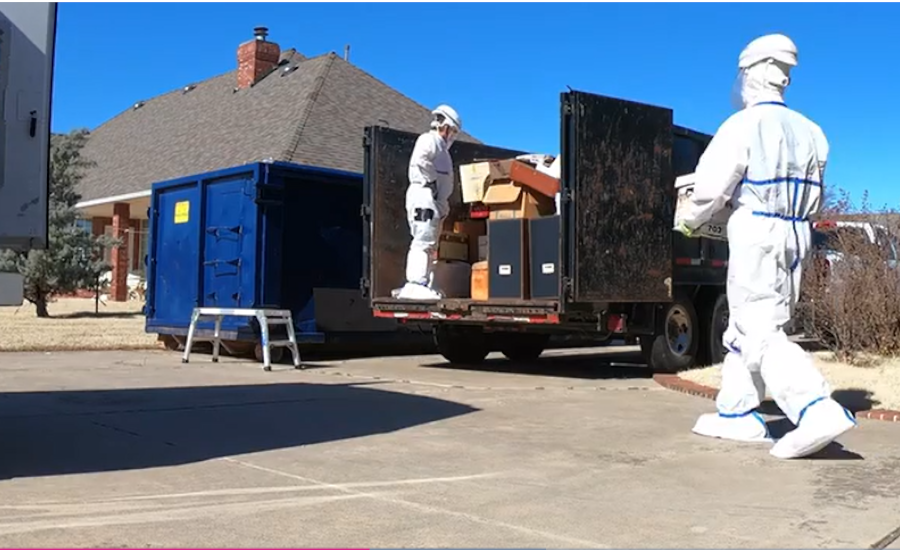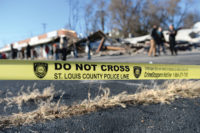Case Study
When Someone Dies Alone
A forensic restoration case study documented on camera.

In the middle of the COVID-19 pandemic, a man passed away in his Oklahoma home, alone. His body wasn’t found until about two weeks later. Two restoration companies came and went, failing to appropriately clean and restore the home. Finally, an adjuster involved in the job reached out to Bio-Sheen Services. With the family’s blessing, and strong desire to save other families from the negative experiences with the two prior companies, Bio-Sheen’s team of forensic operators got to work.
The video above this article tells the story. We dove further into the full scope of the job with a little Q&A with Jeff Jones, forensic operator and owner of Bio-Sheen Services. For the final question, (#10), we also got input from Clay Hernandez, the national director of technical training and sales for Artemis Bio-Solutions.
- How did Bio-Sheen get connected with the job? From there, how was Artemis looped in?
Bio-Sheen was contacted by an adjuster representing a major insurance carrier who, in the past, had worked with Bio-Sheen Services on forensic restoration incident sites involving loss of human life. While the job was pending, it became a topic of conversation between Bio-Sheen and Artemis Bio-Solutions. During the discussion, the possibility of creating a visual documentation of the project came up. The family involved approved, hoping to spare other families of the duress they had experienced while dealing with two other restoration companies.
- How did you create a scope of work for a job with so many variables?
The protocols and procedures involved in this project are part of a very systematic approach that Bio-Sheen Services has been implementing for many years. After the acquisition of critical incident data (who, what, where, when, how), a boots-on-the-ground site assessment was necessary. Donned in proper PPE and MaxAir PAPR respiratory protection systems, two Certified Bio-Forensic Restoration Specialists® took photographs, measurements, vent and return counts, initial ATP scores, and inspected the residence for potential safety issues.
At this time, it was determined where the operation zone, transition zone, and clear zone would be set up. Before the team entered the home, there was an application of an EPA-registered hospital grade Tuberculocidal disinfectant with a 6-log kill, proven to kill both gram negative and gram positive bacteria and inactivate both enveloped and non-enveloped viruses for a pathogenic knockdown, thus creating a safer working environment for the team of Certified Forensic Operators®.
- What was the very first thing you did before technicians/operators got to work? And how were the contents of the home handled?
After discussions with the family, it was determined all contents would be removed. Items to be saved were cleaned and disinfected on site and all other items were placed for proper disposal.
- Were there any odors that needed to be dealt with? If so, how did you do it? Did you need to remove any drywall or flooring?
The Odiferous molecules associated with human composition can be quite pungent. One restoration company had told the family all the sheetrock would have to be removed because of the odor. Following the protocols and procedures developed by Bio-Sheen Services from years of experience, all of the odors were successfully eliminated, saving all of the sheetrock and creating a healthy hygienic environment.
- How many forensic operators were involved in this three-day project? How were you able to assemble a team this size so quickly?
Assembling a team of Certified Forensic Operators® was not a problem. In fact, several team members came from out of state for the opportunity to work on this project, gain more field experience, and have the good fortune to gain more training, in the field, with master forensic restoration trainers, Jeff and Lori Jones. The number of operators was fluid at any given moment. It started with four, at its apex, there were nine Forensic Operators®, and at its conclusion, there were only two, Jeff and Lori Jones.
- What was the biggest challenge on this job?
The biggest challenge on this project was the constant of exchange of the 40 yard roll-a-way dumpsters. This team of Forensic Operators can fill a 40 yard dumpster in 3 to 3.5 hours. We could only get one dumpster exchange per day, which negatively affected our daily production rates.
- What was the biggest success?
The biggest success of this, or any forensic restoration project, is when the client is pleased, but to the operators involved in the project, obtaining ATP scores of Zero gives them a visual validation to the proficiency of their forensic cleaning efforts.
- What were the most critical tools on the job? (i.e. Foggers, microfiber cloths, PAPRs, ATP meters, etc.)
Foggers, microfiber cloths, PAPRs, ATP meters, are just that, tools. It all comes down to the knowledge and skillsets of the person using the tools.
- What PPE did the team wear?
PPE for the Forensic Operators® consisted of microporous suits, external booties, two pairs of hospital-grade nitrile glove, 9-mil exterior glove, and respiratory and eye protection, which was achieved through PAPRs.
- Were you working directly with a family member? How do you approach situations like this when there are so many emotions, and often embarrassment of the conditions?
All of the tools and skillsets in the world mean nothing without care, compassion, and concern for the client.
Communication is everything and the forensic restoration team was in total contact with the family representative on a daily basis. This family had already had bad experiences with two other restoration companies. It was essential they felt this team was their soft place to fall. All of the tools and skillsets in the world mean nothing without care, compassion, and concern for the client. When all is said and done, we are the caretakers of the human condition.
- Was it covered by insurance?
This project was covered by a major insurance carrier.
- What resources are out there for helping remediators determine proper tiers, PPE, scope of work, etc?
There is currently a very limited number of resources available in the marketplace for restoration contractors to turn to that offer extensive hands-on training to negotiate these types of projects. While there are several vendors offering crime scene and trauma cleanup training, for the most part, these courses lack the training required to truly understand not only the science of what is necessary and why, but the psychological preparedness required to perform this type of work.
The reason Artemis is developing a training academy around the Bio-Sheen Services methodologies is to fill that training void. The global pandemic has made it even more clear that the focus of cleaning for building health instead of appearance is more important now than ever before, and the need to teach people the difference could be the difference between life and death.
Looking for a reprint of this article?
From high-res PDFs to custom plaques, order your copy today!







